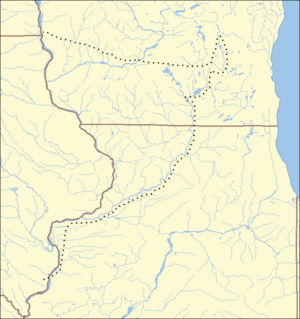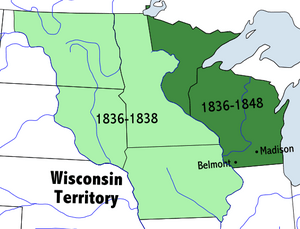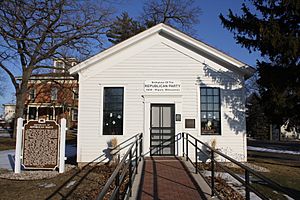History of Wisconsin facts for kids
The history of Wisconsin tells the story of the people who have lived in this land, from the first Native American tribes to the European explorers and settlers, and finally, to the people who built Wisconsin into the state it is today. Wisconsin became the 30th state in the U.S. on May 29, 1848.
Many different groups have made Wisconsin their home. Early settlers included people from New York and New England, called Yankees, who were important in business, finance, and government. Later, many European immigrants arrived, especially Germans and Scandinavians. In the 1900s, more people came from Poland and African Americans settled in cities like Milwaukee.
Politically, Wisconsin was mostly Republican for a long time, but now it's more balanced. The state was a leader in the Progressive Movement, led by Robert M. "Fighting Bob" La Follette. This movement aimed to use knowledge from universities to improve government, which led to the "Wisconsin Idea" and a strong system of state universities.
Contents
Ancient History of Wisconsin

The first people in what is now Wisconsin were Paleo-Indians. They arrived around 10,000 BC, at the end of the Ice Age. When the glaciers melted, Wisconsin became a cold, open land where large animals like mammoths and mastodons lived. Paleo-Indians hunted these big animals, as shown by tools found in places like Boaz, Wisconsin. They also gathered plants from the growing conifer forests. As large animals became rare, people started hunting smaller animals like deer and bison.
Life in the Archaic Period
During the Archaic Period (6000 to 1000 BC), Wisconsin's forests changed, and people continued to hunt and gather. Around 4000 BC, they developed spear-throwers and special copper tools. These tools included axes, knives, and fishhooks. People also made copper jewelry. They found copper ore in Michigan and on Isle Royale in Lake Superior. They shaped copper by hammering and heating it. This "Copper Culture" in the Great Lakes region was very advanced for North America. Later in this period, people started building cemeteries and holding special burials, like the one at Oconto.
Woodland and Mississippian Cultures
The Early Woodland Period began around 1000 BC. During this time, plants became a bigger part of people's diets. Small-scale farming and pottery arrived in southern Wisconsin. They grew crops like corn, beans, and squash, but still needed to hunt and gather. Villages grew along rivers and lakes, and the first earthen burial mounds were built.
Later, the Havana Hopewell culture came to Wisconsin, settling along the Mississippi River. The Hopewell people were part of a large trade network that reached across North America. They built impressive mounds, made fancy pottery, and brought many different minerals to the area. The Hopewell culture likely influenced other groups in Wisconsin.
Around 400 AD, the Late Woodland Period began. People in Wisconsin started using the bow and arrow. Farming continued in the south, and the effigy mound culture became important. These people built earthen mounds in the shapes of animals, which you can still see at places like High Cliff State Park. In northern Wisconsin, people continued to hunt and gather, building cone-shaped mounds.

Around 1050 AD, people of the Mississippian culture moved into Wisconsin and built a settlement at Aztalan. This site was a planned community, possibly connected to the larger city of Cahokia to the south. A wooden fence surrounded the twenty-acre site, which had two large earthen mounds and a central plaza. One mound might have been used for storing food or as a home for leaders, and the other for burials. The Mississippian people grew a lot of corn. Aztalan was abandoned around 1200 AD. Later, the Oneota people built farming villages, similar to the Mississippians but without the large trade networks.
By the time Europeans arrived, the Oneota people had disappeared. The main Native American tribes in Wisconsin were the Dakota Oyate, the Ho-Chunk (Winnebago), and the Menominee. Over time, other tribes like the Ojibwe, Fox, Sauk, and Mahican also moved to Wisconsin.
European Exploration and Settlement
The French Period
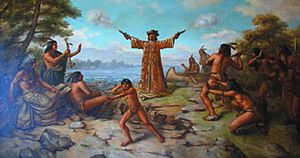
The first European known to have visited Wisconsin was Jean Nicolet in 1634. He was sent by the governor of New France to meet the Ho-Chunk people, make peace, and expand the fur trade. Nicolet traveled through the Great Lakes and entered Green Bay. He met the Ho-Chunk and Menominee people and established peaceful relations before returning to Quebec.
Later, French fur traders like Pierre Radisson and Médard des Groseilliers came to Wisconsin in the 1650s. They traded furs and were the first Europeans to meet the Santee Dakota. Jesuit missionary Claude-Jean Allouez built missions in Wisconsin, meeting tribes like the Potawatomi and Sauk who had moved to the area because of conflicts with other tribes.
In 1673, Father Jacques Marquette and Louis Jolliet explored Wisconsin. They canoed up the Fox River, carried their boats to the Wisconsin River, and then traveled downstream to the Mississippi River. They reached the Mississippi near what is now Prairie du Chien, Wisconsin.
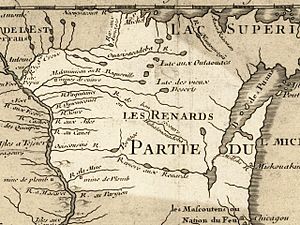
French leaders built forts and trading posts in Wisconsin, like Fort St. Nicholas at Prairie du Chien. These posts were mainly for fur traders and missionaries, not for permanent settlers. The first enslaved black people were brought to Wisconsin during this time by French fur traders and military members.
The Fox Wars
In the 1720s, the Fox tribe, led by Kiala, fought against the French and their Native American allies. The Fox tribe raided French settlements and disrupted trade. This conflict, known as the Second Fox War, greatly reduced the Fox tribe's population. After the war, the Fox joined with the Sauk people.
The British Period
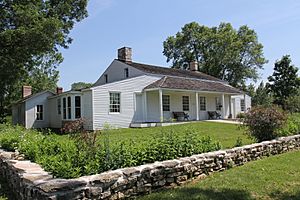
The British slowly took control of Wisconsin during the French and Indian War, gaining full control by 1763. They were also mainly interested in the fur trade. In 1791, two free African Americans even set up a fur trading post in Marinette. The first permanent settlers, mostly French Canadians, arrived during British rule. Charles Michel de Langlade is often seen as the first permanent settler, establishing a trading post in Green Bay in 1745.
The fur trade in Wisconsin was at its peak under British rule. The first self-sustaining farms also started during this time. Green Bay became a successful community, producing its own food and having lively social events.
Wisconsin as a U.S. Territory
The United States gained Wisconsin in the Treaty of Paris (1783). Wisconsin became part of the new Northwest Territory in 1787. Even though it was U.S. land, the British still controlled the fur trade and had alliances with Native American tribes, trying to slow down American expansion.
War of 1812 and Native American Conflicts
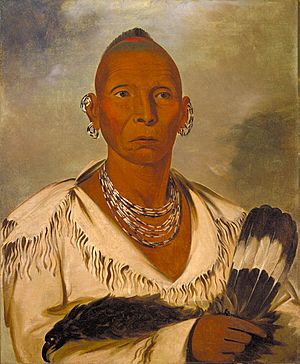
The U.S. didn't fully control Wisconsin until the War of 1812. In 1814, the Americans built Fort Shelby at Prairie du Chien. The British captured it in a battle, but the 1815 Treaty of Ghent gave Wisconsin back to the U.S. To protect the area, the U.S. Army built Fort Crawford and Fort Howard.
Major American settlement was delayed by two Native American wars: the Winnebago War of 1827 and the Black Hawk War of 1832.
The Winnebago War
The Winnebago War began when two Winnebago men were wrongly thought to have been executed. In response, a Winnebago group led by Chief Red Bird attacked settlers near Prairie du Chien. They also attacked boats on the Mississippi River. The group later surrendered to the U.S. Army.
The Black Hawk War
| Map of Black Hawk War sites Symbols are wikilinked to article |
In the Black Hawk War, Sac, Fox, and Kickapoo Native Americans, led by Chief Black Hawk, tried to return to their homeland in Illinois in 1832. This went against a treaty. After a misunderstanding led to a battle, the war began. Six of the war's fifteen battles took place in Wisconsin. The Native Americans were defeated at the Battle of Wisconsin Heights and later at the Battle of Bad Axe. Chief Black Hawk was eventually captured.
Settlement and Lead Mining

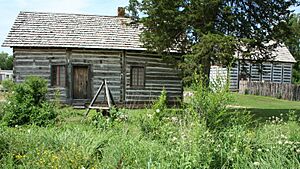
After these conflicts, Wisconsin was open for settlement. Many early settlers came for lead mining in southwest Wisconsin. Native Americans had mined lead there for a long time. Thousands of miners, including experts from Cornwall, England, rushed to the area. Towns like Mineral Point and Platteville quickly grew. By the 1840s, Wisconsin mines produced over half of the nation's lead. Wisconsin earned the nickname "Badger State" because early lead miners lived in tunnels dug into hillsides, like badgers.
While lead mining brought many people, Milwaukee soon became the largest city. Milwaukee started as a trading post in 1795. In the 1830s, three separate settlements formed: Juneautown, Kilbourntown, and Walker's Point. These towns competed fiercely. In 1845, a conflict called the Milwaukee Bridge War broke out over a bridge. In 1846, the three settlements merged to form the city of Milwaukee, with Solomon Juneau as its first mayor. Milwaukee had about 10,000 people and remains Wisconsin's largest city today.
Wisconsin Territory is Formed
The Wisconsin Territory was created on April 20, 1836. It included all of present-day Wisconsin, Minnesota, Iowa, and parts of North and South Dakota. The first territorial governor was Henry Dodge. Lawmakers had to choose a capital city. After much debate, they decided to build a new city called Madison and make it the permanent capital.
Historians describe Wisconsin's development as layers of different groups and influences. These included Native Americans, French, British, fur traders, miners, and loggers. The arrival of railroads marked the end of the frontier era.
Wisconsin Becomes a State
By the mid-1840s, Wisconsin's population was over 150,000, enough to become a state. In 1846, the territorial legislature voted to apply for statehood. They debated a state constitution. The first version was considered very advanced for its time, allowing married women to own property and letting people vote on whether African Americans could vote. However, most Wisconsinites thought it was too radical and voted it down.
In December 1847, a second convention created a more moderate constitution. Wisconsinites approved it in March 1848, and Wisconsin became the 30th state on May 29, 1848. It was the last state east of the Mississippi River to join the Union. With statehood, the University of Wisconsin–Madison was created, becoming the state's oldest public university.
Early State Economy
Lead mining in southwest Wisconsin began to decline after 1848, partly because of the California Gold Rush which drew miners away. The industry continued but was not as strong as before.
By 1850, Wisconsin's population was 305,000. About a third were Yankees from New England and New York. Germans were the second largest group, followed by British immigrants. Yankees were the dominant political group for many years.
Railroads quickly spread across Wisconsin after statehood. The first line opened between Milwaukee and Waukesha in 1851. Railroads helped other industries grow by making it easy to ship products across the country.
Early State Politics
Nelson Dewey, Wisconsin's first governor, was a Democrat. He worked to develop the state's roads, railroads, and canals. He also spoke out against the spread of slavery. Wisconsin became the second state to abolish capital punishment under Governor Leonard J. Farwell.
Between the 1840s and 1860s, new settlers brought new political ideas. Groups against slavery, called abolitionists, formed. Some of these activists helped create the Republican Party. On March 20, 1854, the first local meeting of the Republican Party in the U.S. was held in the Little White Schoolhouse in Ripon, Wisconsin.
A famous example of abolitionism in Wisconsin was the rescue of Joshua Glover, an escaped enslaved person. In 1854, he was caught in Racine and jailed in Milwaukee. A large group of people, led by abolitionist Sherman Booth, helped Glover escape from jail and flee to Canada using the Underground Railroad.
Many immigrants came to Wisconsin in the 1850s, especially Germans, Irish, and Norwegians. Northern Europeans often chose Wisconsin because of its liberal constitution, which gave immigrants the right to vote and become citizens.
Civil War and Economic Growth
Wisconsin in the Civil War
Wisconsin sent 91,379 soldiers to fight for the Union Army during the American Civil War. Over 12,000 Wisconsin soldiers died during the war from battles, wounds, or disease. Many soldiers trained at Camp Randall in Madison.
Some communities, especially those with German immigrants, were unhappy about the draft in 1862. Riots broke out in Milwaukee and other towns, but U.S. troops stopped them.
Most Wisconsin troops fought in the western part of the war. However, some regiments, like the 2nd, 6th, and 7th Wisconsin Volunteer Infantry Regiments, were part of the famous Iron Brigade and fought in major battles in the east, including Gettysburg. The 8th Wisconsin Volunteer Infantry Regiment, known for its mascot Old Abe (a bald eagle), fought in the west.
Growing Industries
Farming in Wisconsin

Farming was very important to Wisconsin's economy in the 1800s. Wheat was a main crop, and Wisconsin produced a lot of it. However, wheat farming wore out the soil and was affected by insects and bad weather. As wheat prices dropped, farmers looked for other crops.
Many farmers turned to dairy farming. This was popular because many settlers came from New York, a leading dairy state. Also, European immigrants brought knowledge of cheese making. The University of Wisconsin–Madison's agriculture school helped dairy farmers improve their methods. By 1915, Wisconsin was the top producer of dairy products in the U.S.
Because of its dairy industry, Wisconsin is known as "America's Dairyland." Wisconsinites are sometimes called "cheeseheads," and foam cheesehead hats are famous, especially with the Green Bay Packers football team.
Brewing Industry
The first brewery in Wisconsin opened in Mineral Point in 1835. By 1860, nearly 200 breweries were operating, with over 40 in Milwaukee. This growth was partly due to the many German immigrants who came to Wisconsin. Four of the largest breweries in the U.S. opened in Milwaukee: Miller, Pabst, Blatz, and Schlitz. Miller still operates in Milwaukee today.
Logging and Timber

In northern and central Wisconsin, where farming was difficult, people worked in logging. Rivers were used to transport logs to sawmills in cities like Wausau and Stevens Point. Railroads later allowed logging to happen year-round and deeper in the forests. Wood products from Wisconsin forests were used for building and furniture in cities like Chicago and Milwaukee. Milwaukee and Manitowoc were also centers for building cargo ships.
Logging was a dangerous job. On October 8, 1871, the Peshtigo Fire burned a huge area of forest, killing between 1,200 and 2,500 people. It was the deadliest fire in U.S. history. By the early 1900s, logging in Wisconsin began to decline as many forests were cleared and new companies in the Pacific Northwest took over.
Wisconsin in the 20th Century
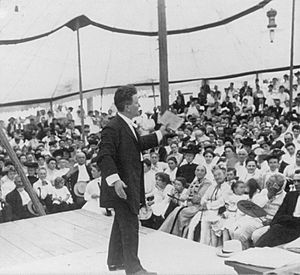
Progressive Reforms
In the early 1900s, Wisconsin became a national leader in the Progressive Era. This movement aimed to improve government and society. Wisconsin created the first statewide primary election system, a law for workplace injury compensation, and the first state income tax. Key leaders included Robert M. La Follette and Governor Francis E. McGovern.
The "Wisconsin Idea" was a commitment by the University of Wisconsin to use its knowledge to develop practical reforms for the state. University professors helped create the first unemployment compensation program in the U.S. in 1932. They also helped develop the plan that became the national Social Security Act of 1935.
World War I and Beyond
During World War I, Wisconsin faced challenges because of its large German immigrant population and some politicians, like Robert M. La Follette, who supported neutrality. Some people called Wisconsin the "Traitor State." However, many Wisconsinites did support the war, and over 118,000 joined the military. Businesses, labor, and farms in Wisconsin also benefited from the war.
After Robert La Follette's death, his sons continued his political legacy, forming the Wisconsin Progressive Party. This party gained popularity in the 1930s, especially with support from President Franklin D. Roosevelt. However, the party eventually declined due to internal conflicts and scandals.
Later 20th Century
In the mid to late 20th century, Wisconsin saw different political movements. Senator Joseph McCarthy led anti-communist efforts in the 1950s. Later, there were strong anti-war protests at UW-Madison in the 1960s and 70s, including the Sterling Hall bombing in 1970.
The state's economy also changed. Heavy industry and manufacturing became less important, and a service economy grew, focusing on medicine, education, agribusiness, and tourism.
|


